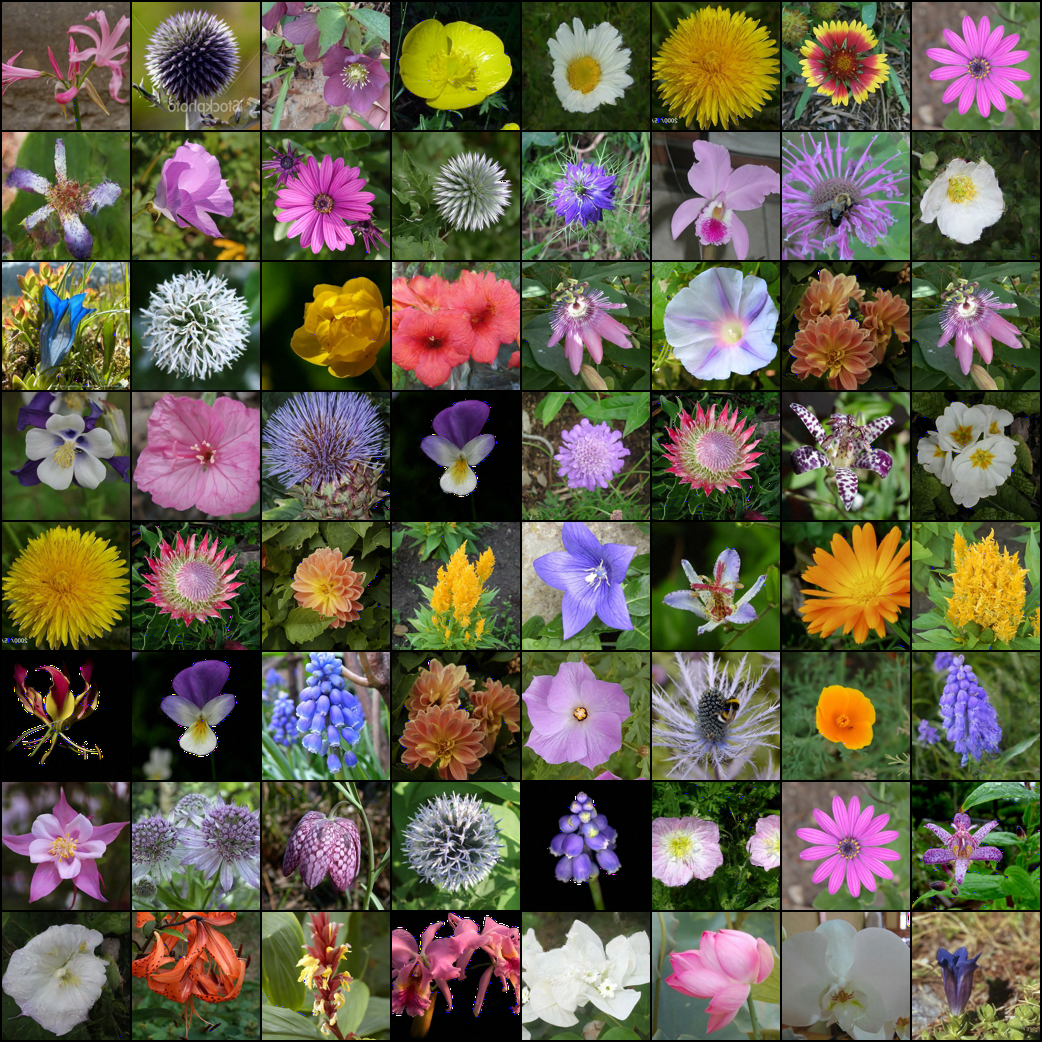This implementation is based on lucidrains's denoising-diffusion-pytorch, where he implemented the original DDPM model proposed from paper Denoising Diffusion Probabilistic Models, as well as latest research findings
I will keep adding new research findings to this repo, let me know if you have any suggestions!
You can run this code and even modify it directly in Google Colab, no installation required:
[https://github.com/yiyixuxu/denoising-diffusion-flax/blob/main/ddpm_flax_oxford102_end_to_end.ipynb]
The Colab also demonstrates how to configure your own training and load pre-trained checkpoint to generate samples on your own!
on going at 27k steps (self-conditioning + P2 weighting)

on going at 85k steps (self-conditioning + P2 weighting)

- write a wandb report about the p2-weighting, self-conditioning and predict_from_x0
- implement gradient accumulation
- implement ddim
python main.py --workdir=./fashion_mnist_cpu --mode=train --config=configs/fashion_mnist_cpu.py If you're new to Jax/Flax ecosystem, you can apply to TPU for free for your research project here https://sites.research.google/trc/about/ (This project is enabled by TRC program. Thank you google!)
See below for commands to set up a single VM with 8 TPUs attached
(--accelerator-type v3-8). For more details about how to set up and
use TPUs, refer to Cloud docs for
single VM setup(https://cloud.google.com/tpu/docs/jax-quickstart-tpu-vm).
First create a single TPUv3-8 VM and connect to it:
ZONE=europe-west4-a
TPU_TYPE=v3-8
VM_NAME=ddpm
gcloud alpha compute tpus tpu-vm create $VM_NAME \
--zone $ZONE \
--accelerator-type $TPU_TYPE \
--version tpu-vm-base
gcloud alpha compute tpus tpu-vm ssh $VM_NAME --zone $ZONE -- \
When connected install JAX:
pip install "jax[tpu]>=0.2.16" -f https://storage.googleapis.com/jax-releases/libtpu_releases.html
Then install denoising-diffusion-flax and required libraries
git clone https://github.com/yiyixuxu/denoising-diffusion-flax.git
cd denoising-diffusion-flax/denoising_diffusion_flax
pip install einops
pip install wandb
pip install --upgrade clu
create a tmux session
tmux new -s ddpm
And finally start the training, to train a model on fashion-mnist dataset with default setting, run
python3 main.py --workdir=./fashion-mnist --mode=train --config=configs/fashion_mnist.py
All examples use read-to-use tensorflow dataset, and have the training process and model checkpoint available on W&B so it is very easy to reproduce
python3 main.py --workdir=./cifar10 --mode=train --config=configs/cifar10.py
W&B project page: ddpm-flax-cifar10
python3 main.py --workdir=./fashion-mnist --mode=train --config=configs/fashion_mnist.py
W&B project page: ddpm-flax-fashion-mnist
python3 main.py --workdir=./flower102--mode=train --config=configs/oxford102_p2_selfcondition.py
W&B project page: ddpm-flax-flower102
By default, we log our model as W&B artifact at end of the training, you can restore your checkpoint from wandb artifact directly by pass the --wandb_artifact argument on commend line; In the example below, we will load our model checkpint from the wandb artifact yiyixu/ddpm-flax-fashion-mnist/model-3j8xvqwf:v0 and continue our training from there
python main.py --workdir=./fashion_mnist_wandb --mode=train --wandb_artifact=yiyixu/ddpm-flax-fashion-mnist/model-3j8xvqwf:v0 --config=configs/fashion_mnist_cpu.py
You can customize your training either by update the config file or overriding parameters on the command line
see more details on how to configure your training from the notebook
You can find example configuration files under configs/ folder - you can create your own configuration file and run
python3 main.py --workdir=./your_test_folder --mode=train --config=configs/your_config_file.py
Specify a hyperparameter configuration by the means of setting --config flag.
Configuration flag is defined using
config_flags.
config_flags allows overriding configuration fields. This can be done as
follows:
python main.py --workdir=./fashion_mnist_cpu --config=configs/fashion_mnist_cpu.py \
--config.training.num_train_steps=100the script can run directly on any TensorFlow dataset, just set the configuration field data.dataset to the desired dataset name. You can find a list of ready-to-use dataset [here](tensorflow dataset name https://www.tensorflow.org/datasets/catalog/overview)
See below the list of hyperparameters for data processing; If you are using TPU with 8 devices, make sure your batch_size is dividable by 8; If you set data.image_size to a different size than your actual image, it will be resized, so make sure to set the size properly
data.dataset
data.batch_size
data.cache
data.image_size
data.channels
It use Weights and Bias logging by default, if you don't already have an W&B acccount, you can sign up here - you will also be given option to create an account when you run the script on comand line
To disable W&B logging, you can override with --config flag on command line
python3 main.py --workdir=./fashion-mnist --mode=train --config=configs/fashion_mnist.py --config.wandb.log_train=False
You can find below list of hyperparameters for W&B logging in config file
wandb.entity = None
wandb.project = "ddpm-flax-flower102"
wandb.job_type = "training"
wandb.name = None
wandb.log_train = True
wandb.log_sample = True
wandb.log_model = True
wandb.entity, wandb.project, wandb.job_type and wandb.name is used to initialize the wandb run; wandb.project is required field because we will create a project with that name to send the run to; all the other fields can be left as None
read more about how to set up these values in Weights & Biase documentation about wandb.init() here
by default, we will log training metrics (wandb.log_train = True), generated samples (wandb.log_sample = True), as well as the final model checkpoint (wandb.log_model = True);
By default, we train our model to predict noise by modifying its parameterization, if you want to predict x_0 directly from x_t, set config.ddpm.pred_x0=True;
The authors of DDPM paper claimed that they it lead to worse sample quality in their experiments
Self-Conditioning is a useful technique for improving diffusion models. In a typical diffusion sampling process, the model iteratively predict x0 in order to gradually denoise the image, and the x0 estimated from previous step is discard in the new step; with self-conditioning, the model will also take previously generated samples as input.
You read more about the technique in the paper Analog Bits: Generating Discrete Data using Diffusion Models with Self-Conditioning
By default, we do not apply self-conditioning; If you wish to apply self-conditioning, set config.ddpm.self_condition=True;
P2 (perception prioritized) weighting optimizes the weighting scheme of the training objective function to improve sample quality. It encourages the diffusion model to focus on recovering signals from highly corrupted data, where the model learns global and perceptually rich concepts.
You can read more about P2 weighting in the paper and check out the github repo
By default, we do not apply P2 weighting. However you can apply it by change the values of p2 hyperparameters in config file, i.e. config.ddpm.p2_loss_weight_gamma and config.ddpm.p2_loss_weight_k;
the paper recomend use p2_loss_weight_gamma=1 and p2_loss_weight_k=1
By default, we will keep track of an exponential moving average version of the model and use it to generate samples. You can find the list of hyperparameters with default values for ema calculation in config file config.ema
ema.beta = 0.995
ema.update_every = 10
ema.update_after_step = 100
ema.inv_gamma = 1.0
ema.power = 2 / 3
ema.min_value = 0.0
ema.inv_gamma and ema.power is used to calculate ema_decay rate for each training step. i.e. ema_decay = (1 + steps / config.inv_gamma) ** - config.power ; ema.min_value and ema.beta determine the minimum and maximum decay rate
by default, we start to average the parameters after 100 steps (ema.update_after_step = 100) and we update the average every 10 steps (ema.update_every = 10)
